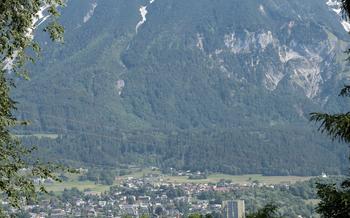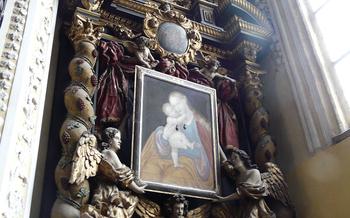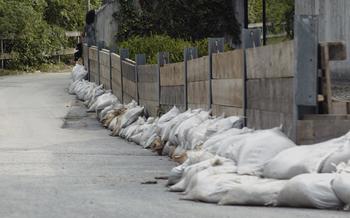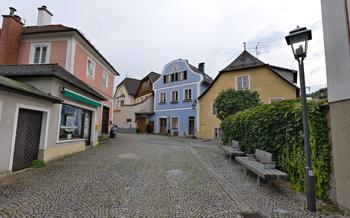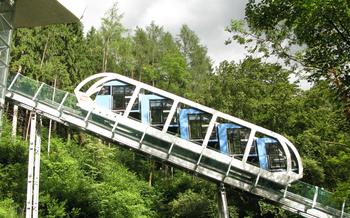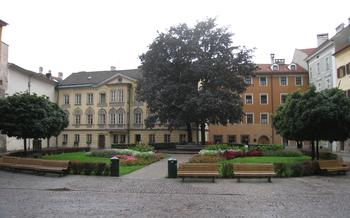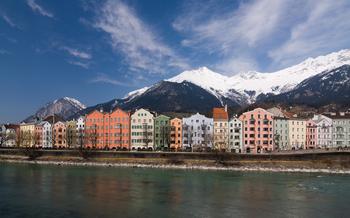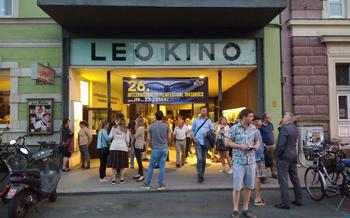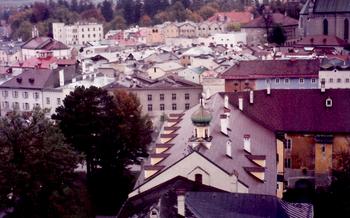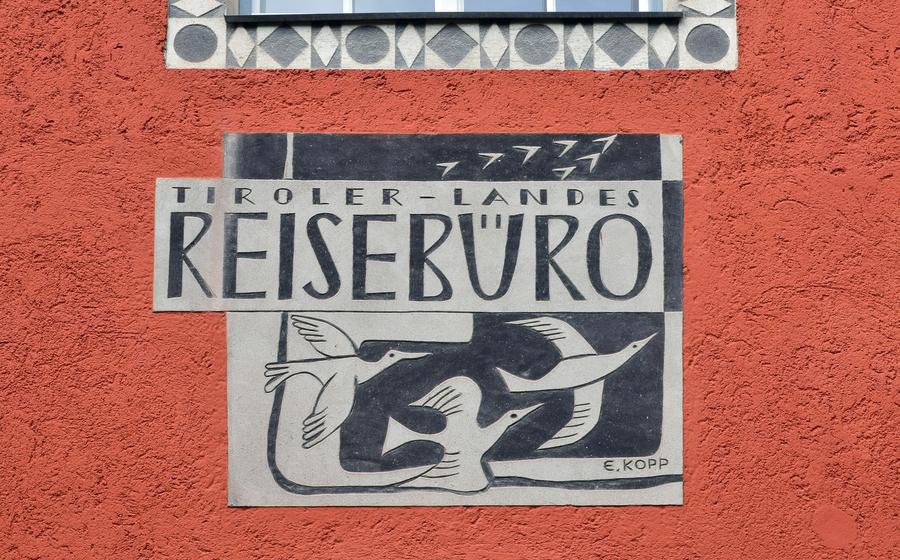
Innsbruck's Golden Roof (Goldenes Dachl)
- Historical Significance of the Innsbruck's Golden Roof
- Architectural Features of the Golden Roof
- Significance of the Roof Tiles
- The Imperial Balcony
- The Frescoes of the Golden Roof
- The Golden Roof Museum
- Visiting the Golden Roof
- Innsbruck's Old Town
- Hofburg Innsbruck
- The Hofkirche (Court Church)
- The Nordkette Mountains: A Majestic Panorama
- Ambras Castle
- The Swarovski Crystal Worlds: Where Crystals Come to Life
- The Tyrolean State Museum: A Journey Through Tyrolean History and Culture
- Insider Tip
Historical Significance of the Innsbruck's Golden Roof
Imst is a vibrant town in the Tyrolean Alps, but to fully experience the region, a trip to Innsbruck, the capital of Tyrol, is a must. Here, you will discover the iconic Golden Roof (Goldenes Dachl), a remarkable architectural masterpiece that holds great historical significance. Commissioned by Emperor Maximilian I in the early 16th century, this three-story bay window covered in approximately 2,700 fire-gilded copper tiles has become an enduring symbol of the city.
Situated in the heart of Innsbruck's Old Town, the Golden Roof stands as a testament to the opulence and power of the Habsburg dynasty. It was designed as a symbol of imperial authority and a stage for lavish court festivities. Every day at noon, the Golden Roof comes alive with a captivating spectacle – the "Männleinlaufen," where life-sized figures emerge from the clock tower and parade across the intricately carved balcony. This centuries-old tradition adds a touch of magic to the already enchanting atmosphere of this historic landmark.
Architectural Features of the Golden Roof
The Golden Roof is a stunning example of Gothic architecture, with intricate carvings, sculptures, and decorative elements adorning its facade. The three-story bay window design is a striking feature of the building, creating a unique and eye-catching effect. The windows are adorned with delicate tracery and intricate carvings, showcasing the skill and artistry of the craftsmen who worked on the Golden Roof.
The use of gilding on the roof tiles adds a touch of opulence and grandeur to the building, creating a striking visual effect that has made the Golden Roof one of the most recognizable landmarks in Innsbruck. The roof tiles are made of copper and were fire-gilded, a process that involved heating the tiles until the gold melted and fused with the copper, creating a durable and visually stunning finish.
Overall, the architectural features of the Golden Roof work together to create a harmonious and visually appealing structure that reflects the power and wealth of Emperor Maximilian I and the artistic achievements of the Gothic period.
Significance of the Roof Tiles
The roof tiles of the Golden Roof are not merely decorative elements; they hold profound symbolic meaning. Approximately 2,700 fire-gilded copper tiles adorn the roof, each one meticulously crafted to reflect the grandeur and power of the Habsburg Empire. The tiles are arranged in intricate patterns, forming a dazzling display that catches the eye and commands attention.
The tiles are not only aesthetically pleasing but also serve as a visual representation of imperial wealth and power. The use of gold, a precious metal associated with royalty, underscores the opulence and extravagance of the Habsburg dynasty. The detailed depiction of Maximilian's coat of arms, prominently displayed on the roof, further reinforces the connection between the Golden Roof and the Habsburg lineage.
In addition to the imperial coat of arms, the roof tiles feature a variety of heraldic symbols and coats of arms, each representing a different noble family or town associated with Maximilian. These symbols serve as a testament to the extensive network of alliances and relationships that the Habsburgs cultivated throughout their reign.
The roof tiles of the Golden Roof are a testament to the craftsmanship and artistry of the era. Their intricate designs, meticulous gilding, and symbolic significance combine to create a stunning visual spectacle that continues to captivate visitors centuries after their creation.
The Imperial Balcony
The Golden Roof's most iconic feature is its imperial balcony, a captivating platform that extends from the center of the bay window, inviting visitors to step back in time and imagine the grandeur of imperial ceremonies. This elevated stage served as a prominent platform for the Habsburg rulers to showcase their power and connect with their subjects.
During official festivities and public gatherings, the imperial family would grace the balcony, displaying their opulent attire and regalia. The balcony became a symbol of power and authority, allowing the Habsburgs to communicate their presence and engage with the city's inhabitants. It was from this elevated platform that proclamations were made, important announcements were delivered, and the loyalty of the people was reaffirmed.
The balcony's strategic location allowed the Habsburgs to observe and participate in the bustling activities of the city below. Parades, markets, and celebrations would unfold before their eyes, creating a lively backdrop for official ceremonies. The imperial family's presence on the balcony added an air of grandeur to these events, transforming them into memorable spectacles that left a lasting impression on the people of Innsbruck.
The Frescoes of the Golden Roof
The Golden Roof is further adorned with a series of captivating frescoes that narrate the life and times of Emperor Maximilian I. These intricate murals were created by Jörg Kölderer, a renowned artist of the Renaissance era. The frescoes depict a rich tapestry of scenes that offer a glimpse into Maximilian's political and personal life. They showcase his military campaigns, diplomatic endeavors, and his deep love of hunting and the outdoors.
Kölderer's artistry shines through in the vivid colors, intricate details, and lifelike figures that populate the frescoes. The scenes are imbued with symbolism and allegories, inviting viewers to delve deeper into the complexities of Maximilian's reign and his vision for the Holy Roman Empire. These frescoes stand as a testament to the artistic and cultural achievements of the Renaissance period and contribute to the Golden Roof's status as an enduring symbol of Innsbruck's rich heritage.
The frescoes on the Golden Roof have undergone extensive restoration efforts over the centuries, ensuring their preservation for future generations. Today, they remain a captivating attraction for visitors, offering a unique blend of art, history, and symbolism that transports them back in time to the era of Emperor Maximilian I.
The Golden Roof Museum
Within the confines of the iconic Golden Roof, a treasure trove of history awaits in the form of the Golden Roof Museum. This fascinating museum provides an immersive journey into the life and times of Emperor Maximilian I, shedding light on the man behind the opulent facade. Artifacts, documents, and interactive displays bring the era to life, offering a glimpse into the customs, traditions, and grandeur of the Habsburg dynasty.
The museum's collection boasts a wealth of historical artifacts, including replicas of Maximilian's armor and weaponry, as well as personal items that offer a glimpse into his daily life. Visitors can delve into the intricacies of Maximilian's political and personal relationships through the examination of letters, treaties, and other documents. Interactive displays engage visitors, allowing them to explore the history of the Golden Roof and its significance in shaping the identity of Innsbruck.
A visit to the Golden Roof Museum is a journey through time, transporting visitors to the heart of the Habsburg Empire and providing a deeper understanding of the man who shaped the destiny of Innsbruck. Whether you're a history buff, an art enthusiast, or simply curious about the stories behind iconic landmarks, the Golden Roof Museum promises a rich and rewarding experience.
Visiting the Golden Roof
Visiting the Golden Roof is a must-do experience for anyone visiting Innsbruck. The entrance fee is reasonable, and the operating hours are accommodating, allowing for flexibility in planning your visit. To make the most of your experience, consider visiting during the morning or late afternoon when the lighting is most favorable for capturing stunning photographs of the intricate details of the roof and surrounding area. Guided tours are available for those seeking a more in-depth understanding of the history and significance of the Golden Roof. These tours provide insights into the symbolism and stories behind the frescoes and carvings, enhancing the overall experience. To avoid long queues, particularly during peak tourist season, it's advisable to book your tickets in advance online or through local tour operators.
Innsbruck's Old Town
Just a stone's throw from the Golden Roof lies Innsbruck's Old Town, a medieval gem brimming with historic charm. Its cobblestone streets, pastel-colored buildings, and Gothic architecture transport visitors back in time. Admire the stunning views of the surrounding mountains and soak in the lively atmosphere as you wander through its narrow streets.
Innsbruck's Old Town is a shopper's paradise, with a plethora of boutiques, art galleries, and specialty shops offering unique souvenirs and handcrafted treasures. Indulge in traditional Tyrolean cuisine at one of the many charming restaurants or cozy cafes, or simply relax and soak up the ambiance of this enchanting neighborhood.
Don't miss the chance to visit the Old Town Hall, a stunning example of Renaissance architecture, or the City Tower, which offers panoramic views of the city. Innsbruck's Old Town is a vibrant cultural hub, hosting various events and festivals throughout the year, including concerts, art exhibitions, and traditional markets.
With its rich history, stunning architecture, and vibrant atmosphere, Innsbruck's Old Town is a must-visit for anyone exploring the city.
Hofburg Innsbruck
In the heart of Innsbruck's Old Town, nestled amidst enchanting cobblestone streets and medieval architecture, stands the majestic Hofburg Innsbruck. This former imperial palace, once the grand residence of the Habsburg dynasty, has witnessed centuries of history and remains an architectural masterpiece that captivates visitors from around the world.
Constructed in the 15th century, the Hofburg Innsbruck underwent several expansions and renovations over the years, resulting in a harmonious blend of Gothic, Renaissance, and Baroque architectural styles. Its imposing facade adorned with intricate carvings, elegant balconies, and decorative elements invites visitors to step back in time and immerse themselves in the splendor of a bygone era.
Today, the Hofburg Innsbruck serves as a museum and a government building, housing a treasure trove of historical artifacts, artworks, and exhibits that narrate the captivating story of the Habsburgs and their reign over Tyrol. Visitors can explore the opulent state rooms, admire the breathtaking Giant Hall, and delve into the fascinating history of the empire within the museum's captivating displays.
The Hofkirche (Court Church)
Within the Hofburg complex lies the Hofkirche (Court Church), a stunning testament to the grandeur of the Habsburg dynasty. Emperor Maximilian I, driven by his profound belief in the afterlife, commissioned this magnificent church as his final resting place. Constructed between 1553 and 1563, the Hofkirche epitomizes the transition from Gothic to Renaissance architectural styles.
The exterior of the church captivates with its elaborate Gothic ornamentation, featuring intricate carvings, flying buttresses, and a towering steeple. The interior, however, reveals a harmonious blend of Gothic and Renaissance elements, creating a space of both reverence and awe. The nave, with its soaring vaulted ceiling, is adorned with intricate frescoes depicting scenes from the life of Christ.
The centerpiece of the Hofkirche is Maximilian's cenotaph, an elaborate tomb adorned with 28 bronze statues of his ancestors and contemporaries. These life-sized figures, cast by renowned artists of the time, stand guard over the emperor's empty tomb, which remains a poignant reminder of his mortality.
Another highlight of the Hofkirche is the Silver Chapel, a small oratory located behind the main altar. This exquisite chapel, adorned with over 2,000 silver tiles, houses the tomb of Archduke Ferdinand II, who was a passionate collector of art and curiosities. The chapel's walls are adorned with intricate silver reliefs depicting scenes from the life of Christ and the Virgin Mary.
The Hofkirche stands as a testament to the enduring legacy of Emperor Maximilian I and the Habsburg dynasty. Its stunning architecture, intricate artworks, and poignant symbolism make it a must-visit destination for anyone interested in history, art, and spirituality.
The Nordkette Mountains: A Majestic Panorama
Imposing the skyline of Innsbruck, the Nordkette Mountains, with their rugged peaks and pristine landscapes, offer a breathtaking backdrop to the city. These awe-inspiring mountains, part of the Karwendel Alps, are a haven for outdoor enthusiasts and nature lovers alike.
A Scenic Sanctuary: Embracing Nature's Splendor
Standing tall at over 2,300 meters above sea level, the Nordkette Mountains provide a sanctuary for those seeking tranquility and adventure. Majestic peaks, lush forests, and sparkling streams create a picturesque panorama that captivates the senses. Whether you're an avid hiker, an ambitious mountain biker, or a thrill-seeking skier, the Nordkette Mountains offer an array of activities to suit every taste.
Conquering the Peaks: Hiking Trails for Every Level
For those who relish the challenge of ascending mountain trails, the Nordkette Mountains present a diverse network of paths catering to all levels of hikers. From gentle slopes ideal for leisurely strolls to challenging routes that test the limits of endurance, there's a trail for every adventurer. Immerse yourself in the tranquility of nature as you traverse through alpine meadows, encounter cascading waterfalls, and ascend to breathtaking viewpoints that offer panoramic vistas of Innsbruck and its surroundings.
A Cyclist's Paradise: Exploring Mountain Trails on Two Wheels
Mountain biking enthusiasts will find paradise in the Nordkette Mountains. With a variety of trails ranging from beginner-friendly paths to adrenaline-pumping descents, there's something for every level of rider. Experience the thrill of navigating winding trails, conquering steep inclines, and gliding through forests, all while surrounded by breathtaking alpine scenery.
Winter Wonderland: Skiing and Snowboarding Amidst Majestic Peaks
As the snow blankets the Nordkette Mountains, a winter wonderland unfolds, transforming the landscape into a skier's and snowboarder's paradise. With perfectly groomed slopes, challenging off-piste terrain, and state-of-the-art facilities, the Nordkette Mountains offer an unforgettable skiing and snowboarding experience. Carve your way down pristine slopes, feel the exhilaration of gliding through powder snow, and soak in the breathtaking views of the snow-capped peaks.
Reaching for the Heights: Convenient Cable Car Access
To fully embrace the beauty and adventure of the Nordkette Mountains, take advantage of the convenient cable car system. The Nordkette Cable Car whisks visitors from the heart of Innsbruck to the Seegrube mountain station, situated at an altitude of 1,905 meters. From there, a second cable car, the Hafelekarbahn, takes you to the summit of the Hafelekar, the highest point of the Nordkette Mountains at 2,334 meters above sea level. Prepare to be mesmerized by the stunning vistas that unfold before your eyes.
Ambras Castle
A Jewel of the Renaissance Era
Sitting majestically on a hill overlooking Innsbruck, Ambras Castle is a testament to the grandeur of the Renaissance period. Built in the 16th century as a hunting lodge for Archduke Ferdinand II, this architectural masterpiece exudes elegance and opulence. Its Renaissance-style design, characterized by symmetrical facades, intricate carvings, and decorative elements, transports visitors back in time to an era of artistic and cultural flourishing.
Ambras Castle is renowned for its stunning gardens, which blend seamlessly with the natural beauty of the surrounding landscape. Visitors can stroll through the manicured lawns, admire the vibrant flowerbeds, and marvel at the meticulously sculpted hedges. The gardens offer a serene oasis, inviting visitors to relax and soak in the tranquility of the surroundings.
The castle's interior is equally captivating, housing the Ambras Castle Museum and its impressive collection of art and artifacts. The museum showcases a diverse range of exhibits, including a renowned collection of armor, weapons, and hunting trophies. Visitors can also explore galleries dedicated to fine art, sculptures, and decorative arts, providing a glimpse into the artistic and cultural tastes of the Habsburg dynasty.
Among the highlights of the museum is the Chamber of Curiosities, a cabinet of curiosities that displays a fascinating array of natural specimens, scientific instruments, and exotic artifacts. This collection reflects the Renaissance fascination with the natural world and the pursuit of knowledge.
Ambras Castle is a must-visit destination for anyone interested in history, art, and architecture. Its unique blend of Renaissance grandeur, stunning gardens, and captivating museum collections makes it a true gem of Innsbruck and a treasure of the Tyrol region.
The Swarovski Crystal Worlds: Where Crystals Come to Life
Nestled in the village of Wattens, just a short drive from Innsbruck, lies a world of sparkling enchantment and crystal wonders. Welcome to the Swarovski Crystal Worlds, an immersive museum and art installation that celebrates the magic and artistry of Swarovski crystals.
Here, visitors are transported into a realm where crystals take center stage, captivating the senses with their brilliance and beauty. Discover the fascinating history of Swarovski, from its humble beginnings as a family-run glass-cutting business to its rise as a global leader in crystal production.
Embark on a journey through glittering chambers and interactive exhibits, where crystals dance and shimmer in a mesmerizing display of light and color. Marvel at the intricate craftsmanship and artistic creations, from delicate crystal sculptures to stunning chandeliers.
Immerse yourself in the Crystal Cloud, a breathtaking installation featuring hundreds of thousands of crystals suspended from the ceiling, creating a mesmerizing effect that mimics a starry night sky. Explore the Crystal Theater and be captivated by the multimedia show that brings the magic of Swarovski crystals to life.
Whether you're a crystal enthusiast, an art lover, or simply looking for a unique and unforgettable experience, the Swarovski Crystal Worlds is a must-visit destination. Prepare to be enchanted and amazed as you delve into the world of crystal wonders, where imagination meets reality in a truly dazzling display.
The Tyrolean State Museum: A Journey Through Tyrolean History and Culture
Nestled in the heart of Innsbruck, the Tyrolean State Museum stands as a testament to the rich history, culture, and natural wonders of the Tyrol region. Established in 1823, the museum boasts an impressive collection of artifacts, paintings, and sculptures that provide a comprehensive insight into the diverse heritage of Tyrol.
Through its captivating exhibits, the Tyrolean State Museum takes visitors on a journey through time, showcasing the region's transformation from ancient settlements to a modern-day cultural hub. Explore the fascinating history of Tyrol, from its early Celtic and Roman roots to its incorporation into the Habsburg Empire and beyond. Learn about the unique traditions, customs, and lifestyles that have shaped the Tyrolean identity.
The museum's natural history collection offers a glimpse into the region's breathtaking landscapes and its diverse flora and fauna. Discover the secrets of the Tyrolean mountains, forests, and valleys, and marvel at the intricate interconnections between nature and human culture.
A visit to the Tyrolean State Museum is an essential experience for anyone seeking a deeper understanding of Tyrol's rich tapestry of history, culture, and natural beauty. Immerse yourself in the region's stories, traditions, and artistic expressions, and gain a newfound appreciation for the vibrant heritage of Tyrol.
Insider Tip:
-
Enhance your visit by joining a guided tour, where knowledgeable docents will provide insights into the museum's highlights and hidden gems.
-
Don't miss the museum's temporary exhibitions, which often feature captivating displays on specific aspects of Tyrolean history and culture.
-
Combine your visit with a stroll through Innsbruck's Old Town, where you can admire historic buildings, indulge in local delicacies, and soak up the vibrant atmosphere.
Insider Tip
Innsbruck offers visitors a unique opportunity to immerse themselves in the city's rich history and culture. One way to do this is by embarking on the Imperial Walk, a self-guided walking tour that takes you past iconic landmarks and hidden gems. As you stroll along the cobblestone streets, you'll encounter architectural wonders, such as the Golden Roof, the Hofburg, and the Hofkirche. Discover the stories behind these magnificent buildings and learn about the emperors and nobles who once called Innsbruck home.
To make your visit even more memorable, plan your trip to coincide with one of Innsbruck's many festivals or events. The Christmas Market, held annually in November and December, transforms the city into a winter wonderland, with festive stalls, twinkling lights, and the scent of mulled wine filling the air. For classical music enthusiasts, the Innsbruck Festival of Early Music, held in August, offers a feast of concerts and performances in historic venues throughout the city. Whether you're interested in history, culture, or simply soaking up the vibrant atmosphere, Innsbruck has something to offer every traveler.
